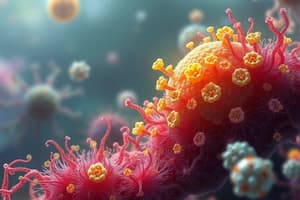Podcast
Questions and Answers
What is systematics?
What is systematics?
Systematics is the branch of biology concerned with the study of the kinds of organisms, their relationships to one another, and their evolutionary history.
What are the two underlying goals of plant systematics?
What are the two underlying goals of plant systematics?
- Identify and classify organisms based on their evolutionary history. Develop new technologies for studying and manipulating genetic material.
- Investigate the impact of human activities on plant biodiversity. Promote conservation efforts to protect endangered plant species.
- Study the structure and function of plant cells. Develop new methods for breeding and cultivating crops.
- Find, describe, give unique names to, and organize into categories the species of plants of the world. Organize plants and plant groups to reflect their evolutionary relatedness and their descent from a common ancestor. (correct)
What type of data are phylogenetic trees based on?
What type of data are phylogenetic trees based on?
Phylogenetic trees are based on the DNA sequences of the cells and provide systematists with new data on which to base their phylogenetic trees.
What is the binomial system of nomenclature?
What is the binomial system of nomenclature?
In the binomial system, the species name is italicized.
In the binomial system, the species name is italicized.
What is the Linnaean hierarchical system?
What is the Linnaean hierarchical system?
What is a taxon?
What is a taxon?
What is the most basic division of organisms in the living world?
What is the most basic division of organisms in the living world?
What are the two forms of cellular organization?
What are the two forms of cellular organization?
What are organelles?
What are organelles?
What are the two basic ways organisms obtain nutrients for metabolism?
What are the two basic ways organisms obtain nutrients for metabolism?
What are photoautotrophs?
What are photoautotrophs?
What are chemoautotrophs?
What are chemoautotrophs?
What are heterotrophs?
What are heterotrophs?
What are phagotrophs?
What are phagotrophs?
What are saprophages?
What are saprophages?
All organisms have cell walls.
All organisms have cell walls.
What is the main difference between Bacteria and Archaea regarding their cell walls?
What is the main difference between Bacteria and Archaea regarding their cell walls?
What substance makes up the exoskeletons of lobsters, crabs, cockroaches, and other arthropods?
What substance makes up the exoskeletons of lobsters, crabs, cockroaches, and other arthropods?
What is the basic material of plant cells and those of many algae?
What is the basic material of plant cells and those of many algae?
Most organisms move around.
Most organisms move around.
What is flagellum and what is its function?
What is flagellum and what is its function?
What is cilium?
What is cilium?
Reproduction is the creation of new individuals from existing ones.
Reproduction is the creation of new individuals from existing ones.
Gametes are haploid.
Gametes are haploid.
What is fertilization?
What is fertilization?
Asexual reproduction occurs in all organisms.
Asexual reproduction occurs in all organisms.
What is fission?
What is fission?
What is budding?
What is budding?
What are spores and what is their function?
What are spores and what is their function?
What is the general theme of life cycles?
What is the general theme of life cycles?
What are the three basic types of life cycles?
What are the three basic types of life cycles?
What is zygotic meiosis?
What is zygotic meiosis?
What is gametic meiosis?
What is gametic meiosis?
What is sporic meiosis?
What is sporic meiosis?
What are the three major groups (sometimes called domains) of organisms?
What are the three major groups (sometimes called domains) of organisms?
Archaea and Bacteria are generally small, mostly unicellular organisms.
Archaea and Bacteria are generally small, mostly unicellular organisms.
Archaea and Bacteria replicate by fission.
Archaea and Bacteria replicate by fission.
Archaea and Bacteria lack membrane-bound organelles.
Archaea and Bacteria lack membrane-bound organelles.
Archaea and Bacteria have the same chemical structure of certain cellular components
Archaea and Bacteria have the same chemical structure of certain cellular components
What are eukaryotes?
What are eukaryotes?
What is the Three-Domain System?
What is the Three-Domain System?
What are protists?
What are protists?
What are fungi?
What are fungi?
What are plants?
What are plants?
What are animals?
What are animals?
What are monerans?
What are monerans?
Viruses are living things.
Viruses are living things.
What are the three main properties that distinguish viruses from their host cells?
What are the three main properties that distinguish viruses from their host cells?
What are the two types of nucleic acid found in viruses?
What are the two types of nucleic acid found in viruses?
Viruses can synthesize their own protein and nucleic acid.
Viruses can synthesize their own protein and nucleic acid.
What is the structure of a virus particle?
What is the structure of a virus particle?
All viruses have the same size and shape.
All viruses have the same size and shape.
What is the function of the capsid?
What is the function of the capsid?
What are the two main types of capsid symmetry?
What are the two main types of capsid symmetry?
What determines the length of a helical capsid?
What determines the length of a helical capsid?
What is the structural difference between the icosahedral capsid and the elongated icosahedral capsid?
What is the structural difference between the icosahedral capsid and the elongated icosahedral capsid?
Viruses can only reproduce in living cells.
Viruses can only reproduce in living cells.
What are the two main types of nucleic acid found in viral genomes?
What are the two main types of nucleic acid found in viral genomes?
All viruses have the same type of nucleic acid genome.
All viruses have the same type of nucleic acid genome.
What are the four categories of virus genomes?
What are the four categories of virus genomes?
The majority of fungal viruses have ssRNA genomes.
The majority of fungal viruses have ssRNA genomes.
The majority of plant viruses have dsDNA genomes.
The majority of plant viruses have dsDNA genomes.
The majority of prokaryotic viruses have ssRNA genomes.
The majority of prokaryotic viruses have ssRNA genomes.
What is the difference between a sense RNA virus and an antisense RNA virus?
What is the difference between a sense RNA virus and an antisense RNA virus?
The largest virus genomes are larger than the smallest cellular genomes.
The largest virus genomes are larger than the smallest cellular genomes.
Flashcards
Systematics
Systematics
The branch of biology that studies organisms, their relationships, and evolutionary history.
Phylogenetic Tree
Phylogenetic Tree
A graphical representation of evolutionary relationships, showing divergences and common ancestry.
Binomial Nomenclature
Binomial Nomenclature
A system of giving each organism a unique, two-part scientific name (genus and species).
Taxonomic Hierarchy
Taxonomic Hierarchy
Signup and view all the flashcards
Genus
Genus
Signup and view all the flashcards
Species
Species
Signup and view all the flashcards
Autotroph
Autotroph
Signup and view all the flashcards
Heterotroph
Heterotroph
Signup and view all the flashcards
Nucleus
Nucleus
Signup and view all the flashcards
Cellularity
Cellularity
Signup and view all the flashcards
Study Notes
Introduction to Systematics
- Systematics is the branch of biology studying organism types, relationships, and evolutionary history
- Two main goals are:
- Classifying and naming plant species globally
- Reflecting evolutionary relationships and common ancestry in plant groupings
- Modern systematics is driven by molecular biology discoveries, especially DNA sequencing
- Phylogenetic trees visually represent evolutionary divergence
- Oldest ancestors near the base, youngest descendants near the top
Binomial System of Nomenclature
- A standardized naming system for organisms
- Each organism has a unique two-part Latin name (genus + species)
- The genus name is capitalized, while the species name is not
- The name is italicized in print
Taxonomic Hierarchy
- The Linnaean hierarchical system groups organisms by increasing inclusiveness
- Species are grouped into genera, genera into families, families into orders, and so forth, up to kingdoms
- 'Taxon' is a general name given to the members of any level in the hierarchy
Evolutionary History
- Linnaeus' ideas transformed biological classification in the 18th century
- Darwin's theory of evolution revolutionized biology in the 19th century
- Molecular sequencing significantly changed phylogenetic understanding in the 20th century
Defining and Classifying Organisms
- Biologists use specific organism features for classification:
- Presence/absence of a nucleus
- Unicellular/multicellular structure and organelles
- Mode of nutrition
- Presence/absence of cell walls
- Cell wall composition
- Motility
- Reproduction methods
- Life cycle patterns
The Cell Nucleus
- The nucleus is an organelle containing the majority of genetic material (DNA)
- A nuclear membrane surrounds the nucleus
Cellular Organization
- Some organisms are unicellular, while others are multicellular
- Some unicellular organisms form filaments, sheets, or colonies
Nutrition Strategies
- Autotrophs produce their own food (photoautotrophs use sunlight, chemoautotrophs use chemicals)
- Heterotrophs obtain nutrients from other organisms (herbivores, carnivores, omnivores, saprophages)
Cell Walls
- Most organisms, except animals and some protists, have cell walls
- Bacteria have peptidoglycan cell walls
- Fungi have chitin cell walls
- Plant cells have cellulose cell walls
Motility
- Many organisms are motile (able to move)
- Various movement methods include flagella, cilia, or pseudopodia
- Some are sessile (attached)
Reproduction
- Reproduction can be asexual (no gametes) or sexual (fusion of gametes)
- Common asexual methods include fission, budding, and spore formation
- Sexual reproduction often involves alternation of generations
Life Cycles
- Three basic types of life cycles exist:
- Zygotic meiosis (haploid organisms, diploid zygotes)
- Gametic meiosis (diploid organisms, haploid gametes)
- Sporic meiosis (alternation of generations)
Domains of Life
- Currently, three domains of life are recognized:
- Archaea (also called Archaebacteria), Bacteria (also called Eubacteria), and Eukarya (or eukaryotes)
- Archaea and bacteria are prokaryotic (no nucleus or membrane-bound organelles)
- DNA is circular
Viruses
- Viruses are characterized by a nucleic acid core (DNA or RNA) surrounded by protein
- Viruses require living cells to replicate
- Classification:
- Size, nucleic acid, and metabolic capabilities are important
- Symmetry (helical or icosahedral (20-sided)) is significant
- Some have envelopes, derived from host cell membranes
- Viruses are non-cellular
- Conical and rod-shaped capsids: some viruses have these shapes
Studying That Suits You
Use AI to generate personalized quizzes and flashcards to suit your learning preferences.




